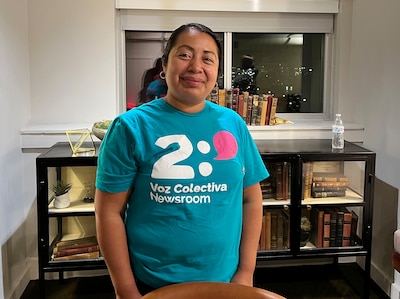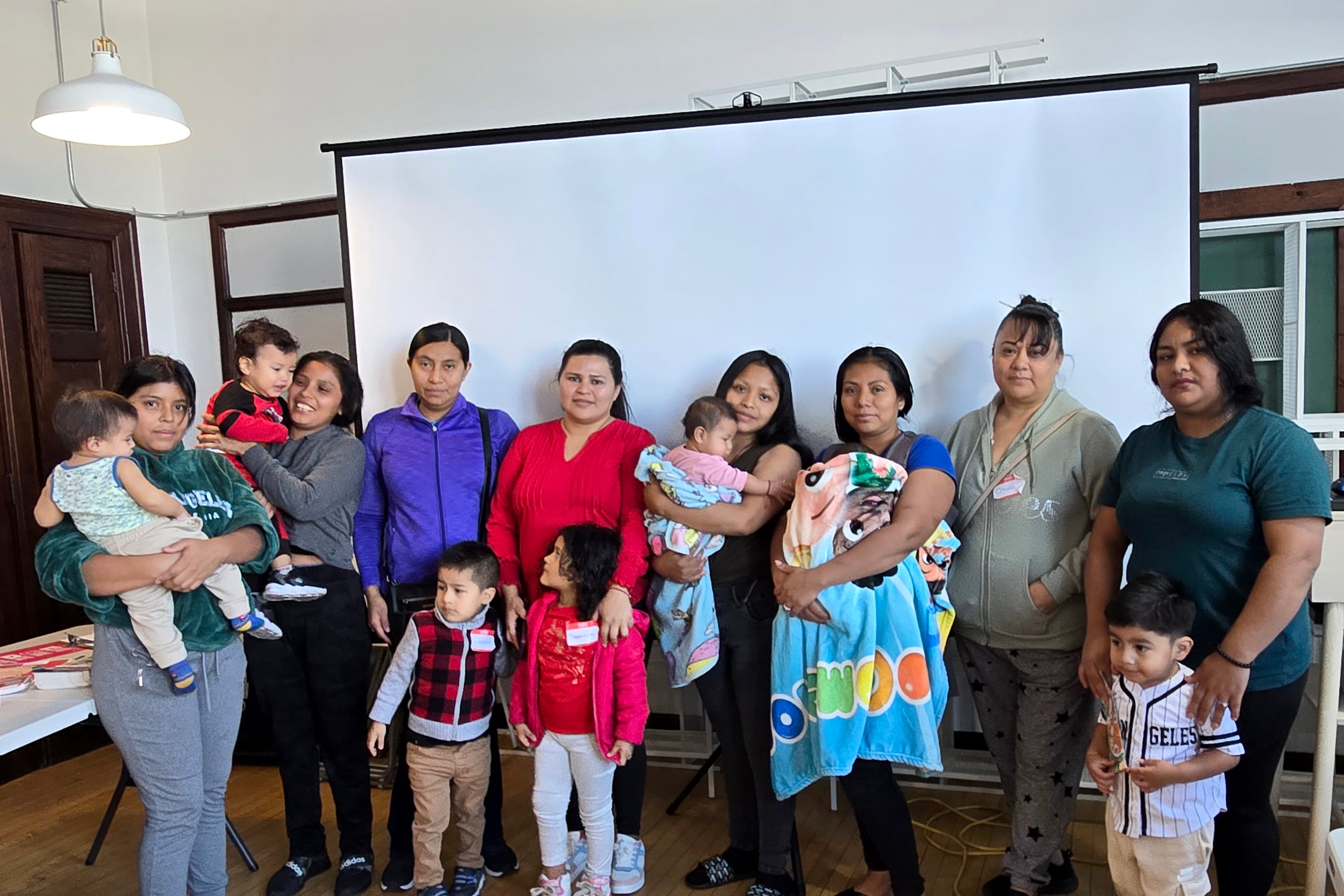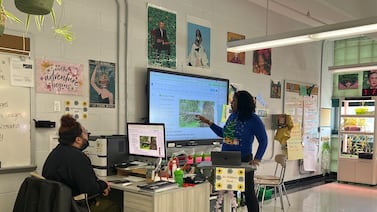Sign up for Chalkbeat Philadelphia’s free newsletter to keep up with news on the city’s public school system.
Does the Philadelphia school district fail to communicate effectively and frequently enough with its Latino families for their children to do as well as they should?
For Zulma Guzmán, the clear answer is yes.
Guzmán, an immigrant mother of four from El Salvador, has witnessed firsthand the challenges of obtaining information and sees how difficult it can be to access translation services. She has spent years helping Latino parents navigate the school system through her work as a community activist and member of VozColectiva, a community newsroom serving the city’s Latino population.

During this time, she said parents have frequently told her that they often miss important information about their children’s school due to language barriers and a lack of resources available in Spanish. Guzmán said Latino parents often tell her the district’s translation services and its work to help English language learners, among other programs, are not enough to meet their needs.
“We need more support, and [schools] always apologize for not having translation services,” she said. “I just don’t understand.”
Questions about how well district schools are connected to and serving these families have become more urgent in recent years. The number of Latino students has increased by 51% since 2018, and they now make up nearly a quarter of the district’s students. Many of the district’s new students are English learners who speak Spanish or Portuguese at home. At the same time, Latino students’ post-pandemic attendance rates lag behind the rates of their white and Asian peers, their state test scores rank at or near the bottom, and they are less likely to attend the city’s most selective schools, the local advocacy group Children First recently reported.
In recent months, Latino parents discussed the challenges they face with the district at a series of roundtables led by 2PuntosPlatform, a local media outlet. They reported feeling left out of services provided by the district and at times fearful of asking for help from their schools, especially given the Trump administration’s policies.
2PuntosPlatform convened the roundtables to hear about Latino parents’ experiences with the school system in a safe setting. Seven to eight people participated in each roundtable; they were not affiliated with 2PuntosPlatform, and Guzmán helped guide one of the discussions.
2PuntosPlatform will report its findings to the school district when all of the roundtables are concluded.
Parents at the roundtables said they missed information about the availability of the school nurse, classes being canceled, and changes in the school bus schedule because they couldn’t communicate effectively with school administrators and teachers. Schools nationwide are grappling with similar challenges as their newcomer and migrant student populations have grown.
District officials say they stand behind its services to Latino families.
Christina Clark, a district spokesperson, said in an email that the district’s Office of Family and Community Engagement is not aware of any issues with families getting translation services, including via Let’s Talk, the district’s platform to help parents and guardians access resources. But she noted the district is working to find new methods to serve this growing demographic.
“We are always reviewing our practices and access to our website to ensure Language Access Services are easier to find and access, and that our district website is user, family, and community-friendly,” Clark wrote.
However, parents at one of 2PuntosPlatform’s roundtables said that it wasn’t as easy to access resources to help them when they face issues, and that sometimes they don’t even know those mechanisms are available.
“Some of the things or resources we have [like translators] aren’t accessible. Information that is accessible to others is not accessible to us,” said Heidy, a district parent, at a 2PuntosPlatform roundtable. “And then this makes us think that we don’t have rights because we don’t know English.” (Chalkbeat is using only first names for Heidy and other parents because of heightened political scrutiny of Spanish-speaking immigrant communities.)
Latino parents share struggles with school system
In the roundtable discussions, mothers reported that having access to translation services is a game-changer when it comes to communicating with their children’s teachers. They told 2Puntos facilitators that when they are able to use a translator, parent-teacher conferences are very useful.
Michelle, a parent who participated in a roundtable discussion, said she finds that the translation services at her school improve her communication with her daughter’s teacher.
But Yessenia, who has two daughters in district schools, said she struggled to participate in her parent-teacher conferences because there was only one interpreter available for all the parents who don’t speak English.
“You have to go at your designated time and you can’t wait for the liaison to be available, so if you are lucky enough, you will get help. But if not, you still need to get in regardless,” said Yessenia.
The lack of professional translators makes it harder for parents and teachers to communicate effectively about the challenges Hispanic students might be facing in the classroom, she said.
The federal Equal Educational Opportunities Act of 1974 states that public schools must ensure English learner students have access to “appropriate language assistance services” so they can get a proper education.
Yessenia said she had a great experience when her daughters were in a Philadelphia Head Start program for prekindergarten, as it offered help for Hispanic families like hers. However, when they moved to higher grade levels in the K-12 system, her family received less individualized support.
Now her daughters are in first and fourth grade, and Yessenia said she’s run into challenges trying to communicate with their school.
“It’s a lot harder, and you find a lot of barriers because sometimes there’s someone at the school who can help,” but it can at times feel like they “simply don’t want to,” Yessenia said.
Instead of receiving services, several Latino mothers told Chalkbeat that they often feel like Spanish-speaking students and bilingual families are being used by their schools as additional translators to supplement the work the district and schools should be doing.
Clark, the district spokesperson, said there are many services to aid families who don’t speak English through the Office of Multicultural Learners. Students have access to an English as a Second Language program, bilingual classes and English development programs. For students in grades 9-12 who arrived in the U.S. within the past year, there are also newcomer learning academies.
The district has increased the number of Spanish Language Bilingual Counseling Assistants and hired more Spanish Language Access Coordinators to aid families, amid the growing number of Spanish-speaking students enrolled in public schools continues to grow, Clark said.
“We recognize that robust language access initiatives are fundamental to ensuring every student can achieve academic success while honoring their unique cultural heritage,” Clark wrote to Chalkbeat.
But parents also said they perceive differences between services for English learners and those for their peers.
Yessenia’s daughter is currently part of the English as a Second Language program at her school, but Yessenia feels she is missing out on the more rigorous academic instruction happening in the general education classrooms.
Teachers and school administrators often call on her daughter to help other students, translate announcements, and even make calls to other parents who don’t speak English to speak about their children on the teacher’s behalf, she said.
In the roundtable discussions, mothers reported feeling scared to ask for help in the past because they had negative experiences and struggled to communicate effectively with people due to language and cultural barriers. They said it makes them feel limited and often leads to misunderstandings.
“People always say, ‘Learn English, you are in America,” said Alejandro, a roundtable participant.
The parents told 2Puntos facilitators that they feel like they could do more to participate in their children’s education and set a positive example, so their doubts aren’t passed on to their children.
After participating in the roundtables, Emma Restrepo, founder of 2PuntosPlatforms, said she was moved by the parents’ willingness to learn and get involved in their children’s education.
“I encountered a community that is eager for information and determined to build a better future for their children, despite the stress and fear they live with every day,” Restrepo said. “The most common barrier we saw was the fear of speaking openly. It’s not easy to feel safe being direct or critical, especially in a country where, if you’re Latino and brown, just existing can feel risky.”







